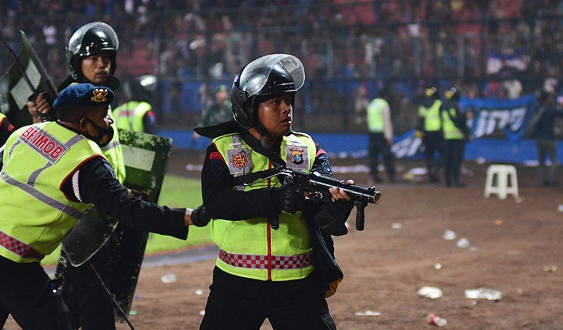- info@ghrd.org
- Mon-Fri: 10.00am - 06:00pm
Kanjuruhan Tragedy and the Culture of Police Violence and Impunity in Indonesia

Kanjuruhan Tragedy and the Culture of Police Violence and Impunity in Indonesia
29-08-2023
Topic: World News
Region: Asia
Angelica Wahono & Vittoria de Bortoli
Team Southeast Asia and Pacific Researcher,
Global Human Rights Defence.
Introduction
On 1st October 2022, at least 125 people, including 33 children, lost their lives and more than 300 were injured after a football match in the Kanjuruhan Stadium in Malang, Indonesia, erupted into rioting and stampede. Riot officers beat soccer fans with sticks and shields and, without warning, sprayed tear gas at tens of thousands of spectators crowded in the stadium. This resulted in a deadly stampede as many supporters rushed through several exit doors, after being suffocated by the tear gas, and trampled on.
The police had repeatedly denied that the high death toll was due to the use of tear gas, a move that was banned by FIFA. However, in its report, the National Commission on Human Rights (Komnas HAM) found that the use of tear gas was a crucial aspect that led to the deaths of hundreds. Choirul Anam, a Commissioner of Komnas HAM, also added that laboratory test results confirmed that the tear gas used by the security personnel had expired which caused constituent chemical components to change, thus making it harmful if exposed to humans. Not only that, the report found that the use of tear gas by the police had violated procedures, as personnel in the field failed to coordinate with the Malang Police Chief, who was in charge during the match that night.
The Kanjuruhan incident has angered many, particularly due the police force’s lack of empathy and seeming eagerness to escape accountability on multiple occasions. Following the tragedy, the official twitter account of the Srandakan police force in Yogyakarta tweeted a number of responses including “modyarr (die)“ and “salut pak tentara, musnahkan (kudos to the army, destroy them).” The police also shared news about riots happening in the stadium prior to the stampede, the use of tear gas being in accordance with the Standard Operating Procedure, and other narratives including the aforementioned lack of fatality due to tear gas in an attempt to shift the blame from them. Additionally, the police cancelled the autopsy of several victims and improperly conducted the reconstruction of events in a different football stadium which, according to the Secretary General of the Commission for Missing Persons and Victims of Violence, Andfi Irham, counts as an obstruction of justice.
Unfortunately, the Indonesian police’s use of repressive violence and subsequent cover-up attempt is not without precedent. This tragedy, which is considered one of the worst disasters in the history of the sport, has put into the spotlight the severe problem of police violence and impunity in Indonesia.
Brutality Culture: Acts of police violence in recent years
The incident is yet another example of the violence that has been faced by tens of thousands of Indonesians throughout the past few years at the hands of the police force. In late 2020, Amnesty International documented at least 411 victims of police brutality in 15 provinces and 6658 arrests across 21 provinces during the nationwide protest challenging the Omnibus Law on Job Creations. From 51 videos verified by Amnesty International’s Crisis Evidence Lab and Digital Verification Corps and Amnesty Indonesia, it was shown the Indonesian police had committed several human rights violations, including beatings, torture, and other ill-treatment.
One important thing to note from the videos is that during the protests many plainclothes police were present, some of them were also inciting violence and conducting arrest. This goes against General Comment 37 of The UN Human Rights Committee which states that the use of plainclothes officers in assemblies must be strictly necessary in the circumstances, they are not allowed to incite violence, and before carrying out any arrests, they need to identify themselves to the persons concerned.
Protesters in Papua who were peacefully opposing the renewal of the Papuan Special Autonomy Law in August 2021 were also faced with similar treatments of violence by the police. They were targeted with water cannons, kicked, punched, and beaten with guns and rubber batons. Three of the protesters were reportedly called “monkeys” by police forces during their arrests.
Unfortunately, police violence in Papua is not a foreign occurrence. The region has been plagued with conflicts between security forces and the Papuan independence movement since it came under Indonesian authority in 1962. In January, the Indonesian Human Rights Commission documented that of 1,182 violent incidents recorded in the restive region, at least 480 or 41.3 percent were committed by security forces.
Civilians also fall victim to violence. Mohammad Choirul Anam, commissioner and spokesman of Indonesia’s National Commission on Human Rights, stated that security forces were involved in the shooting and torturing of civilians as well as the burning and destruction of schools and homes. In October last year, the police shot dead Mr Surya Wenda and injured two others in Wamena.
Impunity Prevails
Unfortunately, any investigation into allegations of police misconduct is left entirely to top officials to investigate, and most of the time, they are not even carried out. Wirya Adiwena, deputy director of Amnesty International Indonesia, said that “there almost never has been” any trial over the excessive use of police force except in 2019, when two students were killed on Sulawesi Island during protests. Fatia Maulidiyanti, coordinator of the Commission for Missing Persons and Victims of Violence shared the same sentiment, saying that the government has been covering up and restricting the international community’s access to information in regards to violence in Papua.
Despite this lack of accountability, the police force’s budget has been on the rise for the past few years and is the third largest among all government ministries in the country. The majority of this budget has been spent on tear gas, batons, and gas masks. Andri Prasetiyo, a finance and policy researcher, said that in the past decade, the national police have spent about $217.3 million to procure helmets, shields, tactical vehicles, and other implements deployed during protests.
Aftermath of Kanjuruhan: will there be a change?
The Kanjuruhan tragedy has been a wake-up call for many in the country, especially due to the anger it incited from the general public towards the establishment, particularly the national police force. Fortunately, it seemed that the public backlash had been effective in forcing the government and the police force to take some form of accountability in this tragedy. On October 31st, 2022, a month after the incident, the police announced that they will be adding new suspects after examining 93 witnesses and that they will finally detain the 6 original suspects of the tragedy, which includes Head of Malang Police Ops Division Kompol Wahyu Setyo Pranoto, H as a member of the East Java Police Mobile Brigade, and Malang Police Samapta Head AKP Bambang Sidik Achmad.
Conclusion
However, there continues to be minimal justice or accountability in regard to other instances of police violence in the country. Some have called for an internal police reform to change the toxic culture of the institution, which would include an overhaul of their curriculum system such as daily life, paradigms, characters and culture, as well as how they measure crowd control and prevention of the use of fatal actions towards citizens. An overall decrease in the police budget as well as the size of the national police force (Indonesia has one of the largest police forces in the world with roughly 434.135 officers) may also provide a significant change in how the institution operates. However, it remains to be seen if this tragedy will be enough for the national police force and the government to strive for structural change.
Bibliography
Human Rights Organization Reports
Amnesty International, “Indonesia: Investigate verified evidence of police violence during Omnibus Law protests”, Amnesty International (December 2, 2020). Retrieved on October 30, 2022, from: https://www.amnesty.id/indonesia-investigate-verified-evidence-of-police-violence-during-omnibus-law-protests/
Amnesty International, “Indonesia: Papuan protesters shot, beaten and racially abused by security forces – new research”, Amnesty International (August 20, 2021) Retrieved on October 30, 2022, from: https://www.amnesty.org/en/latest/news/2021/08/indonesia-papuan-protesters-shot-beaten-and-racially-abused-by-security-forces-new-research/
International Center for Transitional Justice, ‘The Past That Has Not Passed: Human Rights Violations in Papua Before and After Reformasi’ (International Center for Transitional Justice, 2012) Retrieved on November 1, 2022, from https://humanrightspapua.org/wp-content/uploads/2013/12/images_docs_ICTJ-ELSHAM-Indonesia-Papua-2012-English.pdf
News Articles
Arif Setiawan, “Tragedi Kanjuruhan Polisi Disebut Lakukan Pengaburan dan Penghambatan Pengungkapan Fakta,” Bola Sport (October 21, 2022), Retrieved November 2, 2022 from https://www.bolasport.com/read/313536196/tragedi-kanjuruhan-polisi-disebut-lakukan-pengaburan-dan-penghambatan-pengungkapan-fakta
Human Rights and Peace for Papua, “Police Officers Shoot Dead Papuan Man in Wamena Two Injured by Bullets,” Human Rights and Peace for Papua (17 October 2021) rertrieved on November 2, 2022 from: https://humanrightspapua.org/news/2021/police-officers-shoot-dead-papuan-man-in-wamena-two-others-injured-by-bullets/
Konradus Epa, “Indonesian Security Forces Blasted over Papua Abuses,” UCA News (January 19, 2022) Retrieved on November 1, 2022, from: https://www.ucanews.com/news/indonesian-security-forces-blasted-over-papua-abuses/95779
Leo Galuh, “The Culture Behind Indonesia’s Police Brutality,” Fair Planet (October 12, 2022) Retrieved November 2, 2022 from https://www.fairplanet.org/editors-pick/the-culture-behind-indonesias-police-brutality/
Masrur Jamaluddin, Heather Chen, Raja Razek, Jake Kwon and Kareem El Damanhoury, “At least 125 killed in Indonesia soccer stadium crash”, CNN (October 3, 2022). Retrieved on October 30 2022, from:
Mirza Bagaskara, “Human Rights Group: Tear Gas Led to Multiple Deaths at Kanjuruhan,” Tempo.co (November 1, 2022) Retrieved on November 1, 2022 from: https://en.tempo.co/read/1652438/human-rights-group-tear-gas-led-to-multiple-deaths-at-kanjuruhan
Monavia Ayu Rizaty, “Berapa Jumlah Polisi di Indonesia?” Data Indonesia Id (July 18, 2022) Retrieved November 2, 2022 from https://dataindonesia.id/ragam/detail/berapa-jumlah-polisi-di-indonesia.
New York Times, “Deadly soccer clash in Indonesia puts police tactics, and impunity, in spotlight”, The Indian Express (October 4, 2022). Retrieved on October 30, 2022, from: https://indianexpress.com/article/world/soccer-clash-indonesia-police-tactics-impunity-8188624/
Ra Indrata, “Ada 93 Saksi Diperiksa Tragedi Kanjuruhan Bakal Punya Tersangka Baru,” Malang Post (October 31, 2022), retrieved November 2, 2022, from https://malang-post.com/2022/10/31/ada-93-saksi-diperiksa-tragedi-kanjuruhan-bakal-punya-tersangka-baru/
Rahel Narda Chaterine, “Ironi Polisi di Tragedi Kanjuruhan, Sujud Minta Maaf di Malang, Sibuk Membela Diri di Jakarta”, Kompas (October 11, 2022), Retrieved November 2, 2022 from https://nasional.kompas.com/read/2022/10/11/06300081/ironi-polisi-di-tragedi-kanjuruhan-sujud-minta-maaf-di-malang-sibuk-membela
Wisang Seto Pangaribowo, “Kapolda DI Yogyakarta Didesak Copot Kapolsek Srandakan, Buntut Komentar Tak Pantas Anggotanya di Twitter soal Tragedi Kanjuruhan”, Klik untuk baca: https://yogyakarta.kompas.com/read/2022/10/04/135648378/kapolda-di-yogyakarta-didesak-copot-kapolsek-srandakan-buntut-komentar?page=all.
—, “Indonesia Urged to account for Papua violence”, Radio New Zealand (September 27, 2022). Retrieved on October 30, 2022, from: https://www.rnz.co.nz/international/pacific-news/475567/indonesia-urged-to-account-for-papua-violence
—,“Polisi Dinilai Lepas Tanggung Jawab Soal Korban Tragedi Kanjuruhan,” CNN Indonesia (October 11, 2022) Retrieved November 2, 2022 from https://www.cnnindonesia.com/nasional/20221011175644-12-859188/polisi-dinilai-lepas-tanggung-jawab-soal-korban-tragedi-kanjuruhan
ABOUT US
Global Human Rights Defence (GHRD) is a dedicated advocate for human rights worldwide. Based in The Hague, the city of peace and justice. We work tirelessly to promote and protect the fundamental rights of individuals and communities. Our mission is to create a more just and equitable world, where every person's dignity and freedoms are upheld. Join us in our journey towards a brighter future for all.
ALL CONTACTS
-
Riviervismarkt 5-unit 2.07
2513 AM The Hague - Phone +31 62 72 41006
- info@ghrd.org
-
10:00am - 06:00pm
Saturday & Sunday Closed
SUBSCRIBE
Stay informed and be part of change - Subscribe to our newsletter today!
- Copyright of GHRD 2023. Powered by Desmantle Studio.


Leave a Reply